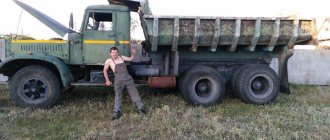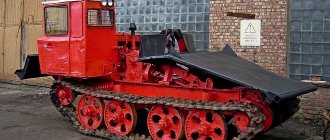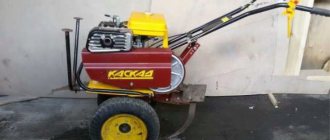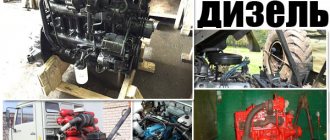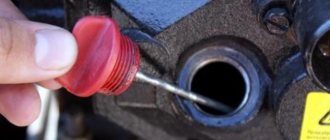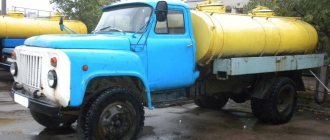Device
- frame
- air and throttle valve
- fuel valve mechanism
- diaphragm
- lid
- main dosing system
- idle system.
The main dosing system includes:
- diffuser B, made in the form of a narrowing of the body,
- reed valve
- spray jet.
Idle system:
- fuel jet G idling
- channels B and D idling
- outlet holes A
- air jet
- mixture adjustment screw
- lever and stop screw on the throttle shaft.
The diaphragm with the body and cover forms two chambers: the upper one above the diaphragm and the lower one below the diaphragm.
The upper chamber through the valve communicates with the fuel tank through the valve, and the spray jet and outlets, A - with the mixing chamber of the carburetor.
The lower chamber is connected to the atmosphere by a balancing hole. The spring-loaded lever keeps the valve closed.
Figure 1. a - general view (top); b - scheme of work (lower figure);
1 - body; 2 - throttle valve; 3— stop screw; 4 - screw for regulating the composition of the mixture; 5 - automatic valve; 6 - air damper; 7 - air jet; 8 - spray jet; 9 - diaphragm; 10 - drowner button; 11 - spring; 12 - lever; 13 - housing cover; 14 and 15 - valves.
2.4. Starting engine. Faults.
The D-240L diesel engine of the MTZ-80L tractor is equipped with a PD-10U starting engine with a power of 7.37 kW (Fig. 2.1.65, 2.1.66).
Main indicators, nominal and permissible dimensions of parts of the starting engine PD-10U
| Crankshaft speed, min-1: | at idle | 3900 — 4200 |
| under load when cranking the diesel engine | 3500 — 3800 | |
| Cylinder diameter, mm: | nominal | 72,00 — 72,03 |
| admissible | 72,17 | |
| Piston diameter, mm: | nominal | 71,79 — 71,82 |
| admissible | 71,50 | |
| Clearance between ring and piston groove, mm | 0,23 | |
| Thickness of clutch discs, mm: | slave or leader | 7,5 |
| clamping | 5,5 | |
A decrease in the power of the starting engine, accompanied by a decrease in the frequency of rotation of its crankshaft and characterized by a drop in compression (pressure in the cylinder), indicates wear of the cylinder-piston group. Compression is checked with a KI-861 compression gauge when the crankshaft is cranked with a starter on a warm engine. The compression value must be at least 0.45 MPa. A decrease in compression to 0.3 MPa indicates the limiting wear of the cylinder-piston group or burning and coking of the piston rings. Interruptions in the operation of the engine and loss of power can be determined by malfunctions of the power system, excessively small or large gap between the spark plug electrodes, as well as between the contacts of the magneto breaker, setting the ignition too late or too early. Difficulty starting the engine indicates insufficient compression in the cylinder, a violation of the tightness of the crankcase and crankshaft seals, and demagnetization of the magneto rotor. Slow cranking of the diesel crankshaft at the rated speed of the crankshaft of the starting engine indicates slippage of the clutch due to wear of its discs, slippage of the overrunning clutch due to wear of its rollers or curly bushing. Premature shutdown of the starting motor is caused by weakening or breakage of the pusher springs, the drive gear disconnector, wear of the protrusions of the weights or the protrusions of the pusher bushing washer. The rattle of the drive gear when turned on and the engagement mechanism is correctly adjusted indicates warping of the clutch discs (the clutch "leads"), breakage of the disc unclamping springs. The technical condition of the starting engine can be determined by measuring the maximum rotational speed of its crankshaft when cranking the diesel engine. In this case, the engine is warmed up to a normal thermal state and using a tachometer, the maximum speed of the crankshaft without load (at idle) is determined. A low idle speed is the result of a clogged air cleaner, a misalignment of the carburetor, a faulty spark plug, or an incorrect adjustment of the speed regulator spring. If the maximum idle speed is within the normal range, then the crankshaft speed of the starting engine is checked when the diesel crankshaft is turned with the fuel supply turned off. If the rotational speed during cranking of the diesel crankshaft and serviceable power and ignition systems is below the specified limit, then this indicates wear of the parts of the cylinder-piston group of the starting engine.
Principle of operation
Close the choke before starting a cold engine . In this case, the throttle valve opens under the action of the starting motor regulator spring. After a long stop of the engine, it is necessary to press the drowner button .
- In this case, the diaphragm presses the lever, the valve opens, and fuel enters the chamber above the diaphragm.
- When the engine crankshaft rotates, a vacuum is created .
- Under the action of vacuum, the fuel enters through the spray jet .
- The air-fuel mixture is fed into the mixing chamber through the idling spray holes, and a re-enriched combustible mixture is formed .
- This creates the conditions for a reliable engine start .
- Immediately after start-up, the combustible mixture becomes leaner , as the automatic valve on the air damper is activated.
- As the engine warms up, open the choke .
Scheme of the device of the starting engine PD-10
The starting motor of this brand consists of a number of components and seems to be a complex technical unit designed to ensure a stable start of the MTZ tractor engine. Studying its device, the following key design elements can be distinguished:
- cylinder. Mounted on the crankcase with nuts. Purge channels, well located tangent to the circumference of the node, reduce the leakage of the mixture with the exhaust. The cylinder head is equipped with a glow plug;
- piston. Manufactured from high strength aluminum alloy. Its distinguishing feature is a spherical bottom, which improves the quality of cleaning the cylinder from exhaust gas. In order to achieve the correct position of the piston, it should be placed in such a way that the arrow on its bottom points towards the rear axle of the crankshaft;
- crank mechanism. Made of special grade steel, equipped with a bronze bushing. The heads of the mechanism are one-piece, and the bearing is double-row, roller type;
- gears;
- crankshaft. Roller bearings with rubber seals act as its support. In order to equalize the centrifugal force, the knees of the cheeks are equipped with special weights;
- the cooling system of the unit is connected to a similar system of the main motor.
Be sure to read: How to set the ignition on the T-40
These elements are key and take the most active part in the operation of this engine. At the same time, there are many other components, such as pins, rings, windows and other accessories.
Idling
After starting the engine, the throttle valve closes under the action of the regulator , and the air valve opens. In diffuser B , the vacuum is small, so no fuel is supplied from the spray jet. The air-fuel mixture passes into the mixing chamber through hole A , since there is a large vacuum behind the throttle valve.
The throttle opening value determines the minimum engine speed at idle.
The position of the damper and the quality of the combustible mixture are regulated by a screw.
Service PD-10
As a rule, the launcher will not require a lot of time from the owner to perform node maintenance work. It is important to remember that the use of fuel in its pure form, without pre-mixing with oil, is strictly prohibited, as this can lead to engine damage and subsequent failure.
In order to fill the engine, you will need to mix clean gasoline of good quality and engine oil in a clean container, strictly observing the proportions of 15: 1. It is necessary to use a special funnel-filter when filling, which will avoid the ingress of large and small contaminants into the internal components of the unit.
Scheme PD-10
As you use, you should flush the sump of the fuel tank, and also wash or replace the air filter in a timely manner. It is recommended to do this every 480 hours of use. Since many of the problems that arise with the launcher are related to the unsatisfactory cleanliness of the air filter, it should be periodically dismantled and cleaned, following the instructions below:
- Remove the protective cap of the air purifier and the restrictive mechanism.
- Remove filter.
- Rinse it in diesel fuel, then moisten it with oil.
- Install filter, restrictor and cap.
It is necessary to pay due attention to the maintenance of the gearbox operating in conjunction with the PD-10. First of all, you should change the oil after 960 hours of operation, and top it up every 480 hours, as needed.
With a similar frequency, the performance of the clutch assembly should be checked. During operation, it is necessary to remember that the launcher operation time should not exceed 10 minutes, otherwise the probability of its failure increases significantly.
Setting and adjustment
From the correct setting of the engine, including PD 10u, its technical performance, as well as stability and efficiency, depend. Adjustment of the device is carried out in several stages, the first of which is considered to be the setting of the carburetor.
Be sure to read: How to make an auger with your own hands
To do this, you should set the length of the rod between the damper and the regulator, after which, adjust the engine at low speeds. After that, they begin to adjust the crankshaft, which can be done using the appropriate spring. The more it is compressed, the higher the engine speed is.
Then, it is necessary to start setting up the ignition system, and the last, final step will be setting up the mechanism responsible for turning off the drive gear.
Load mode
With an increase in the load on the starting engine, the throttle valve opens, the vacuum in the diffuser increases, fuel enters the mixing chamber through the spray jet . As the throttle valve opens, more fuel is fed into the mixing chamber.
The vacuum decreases at the idle holes when the throttle is opened. Therefore, fuel does not enter through these holes, but is distributed only through a spray jet .
As fuel is consumed from the chamber, the pressure above the diaphragm becomes lower than the atmospheric pressure below the diaphragm.
Under the influence of the pressure difference, the diaphragm bends upward , presses the lever and opens the valve. The upper chamber above the diaphragm is filled with fuel. The pressure above and below the diaphragm equalizes as the upper chamber fills, and the diaphragm moves down . The valve closes under the action of a spring, so the cycle repeats.
Starting engine
In order to start the tractor from the launcher do the following:
a) Open the gas valve. Pump fuel into the carburetor and close the air supply damper. You can add gasoline to the cylinders through the decompressor valve, after which the valve is closed .
b) Insert the starter cord into one of the grooves on the flywheel of the starting motor and wind the cord around the flywheel in a clockwise direction when looking at the starter motor from the flywheel side; the second end of the cord must be held in your hands; it is strictly forbidden to wind the cord around your hand, as during a reverse flash it can tighten your hand on the flywheel, which will lead to serious injury;
c) Pull the end of the cord towards you , the starting motor should start to work. If the engine does not start, restart. If the engine could not be started jerkily, clean the crank chamber from fuel condensate, to do this, unscrew the crankcase drain plug, disconnect the drive and the spark plug and, turning the crankshaft by the flywheel, purge the crank chamber. After purging, wrap the plug, secure the wire to the spark plug and restart the engine.
How to start a tractor from a launcher
d) After starting, warm up the starting motor at first at low speed, and then transfer the engine to the speed limited by the regulator.
